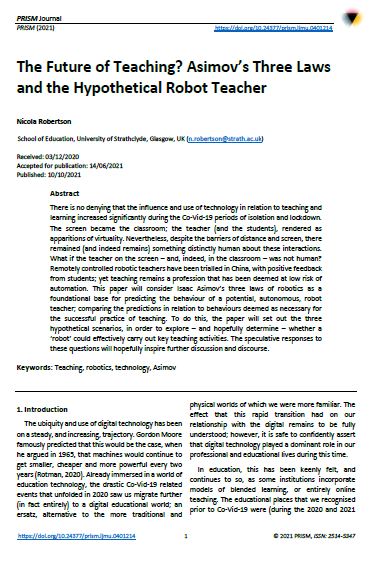The Future of Teaching? Asimov's Three laws and the Hypothetical Robot Teacher
DOI:
https://doi.org/10.24377/prism.ljmu.0401214Keywords:
Teaching, Robotics, Technology, AsimovAbstract
There is no denying that the influence and use of technology in relation to teaching and learning increased significantly during the Co-Vid-19 periods of isolation and lockdown. The screen became the classroom; the teacher (and the students), rendered as apparitions of virtuality. Nevertheless, despite the barriers of distance and screen, there remained (and indeed remains) something distinctly human about these interactions. What if the teacher on the screen – and, indeed, in the classroom – was not human? Remotely controlled robotic teachers have been trialled in China, with positive feedback from students; yet teaching remains a profession that has been deemed at low risk of automation. This paper will consider Isaac Asimov’s three laws of robotics as a foundational base for predicting the behaviour of a potential, autonomous, robot teacher; comparing the predictions in relation to behaviours deemed as necessary for the successful practice of teaching. To do this, the paper will set out the three hypothetical scenarios, in order to explore – and hopefully determine – whether a ‘robot’ could effectively carry out key teaching activities. The speculative responses to these questions will hopefully inspire further discussion and discourse.
Downloads

Downloads
Published
Issue
Section
License
Authors retain copyright and grant the journal the right of first publication with the work.
The version of the article published as part of this issue is licensed under a Creative Commons Attribution-NonCommercial-NoDerivatives 4.0 International Licence and allows others to read, download, copy, distribute, print, search, link to the full text of the first version of this article, or to use it for any other lawful purpose in accordance with the license. The author maintains copyright for the article published in this journal.
This journal provides immediate open access to its content and has no submission or publication fees.


